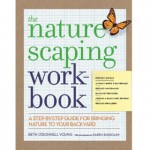RESOURCES FOR ECO-FRIENDLY GARDENERS
Down-to-earth guidance for creating sustainable, attainable landscapes so we can all make a difference in our own yards and in our own communities.
Here are some of my favorite resources for understanding why, what and how to create pleasing, low-care, environment-friendly landscapes – one yard, one school, one shopping center at a time.
Books

West Coast landscape designer Beth Young calls it Naturescaping. She is author of The Naturescaping Workbook: A Step-by-Step Guide for Bringing Nature to Your Backyard (Timber Press). I contributed photographs and an eastern gardener’s perspective to the book.
Beth puts it this way:
“Naturescaping lets you be cheap and lazy and still have the prettiest garden on the block.”
The Naturescaping Workbook follows Entomologist Doug Tallamy’s Bringing Nature Home: How Native Plants Sustain Wildlife in Our Gardens, a must-read with the science to back up a compelling case for the critical importance of native plants and the insects that eat them for the survival of birds.
(Learn more about Karen’s most popular talk, Naturescape Your Yard and check our her Schedule of Talks to see if she will be speaking near you – or book the talk for your group)
Which follows Sara Stein’s Noah’s Garden: Restoring the Ecology of Our Own Backyards (Houghton Mifflin), detailing how our neat and sterile suburban landscapes have devastated not just suburban, but even rural ecology. As Stein says, “Entire communities of plants and insects – the well-stocked pantry of our native countryside – have been wiped bare.” These two books are as earth-shatteringly important as Rachel Carson’ Silent Spring was in sounding the alarm about pesticides.
There is a growing understanding that many land care practices – especially with lawns – are detrimental to the health of people and animals, pollute waterways, consume unconscionable amounts of fossil fuels and are unsustainable in addition to being too darned much noise and work. The Organic Lawn Care Manual by Paul Tukey (Storey Publishing) tells you how to take your lawn organic. www.safelawns.org
Finally, hot off the presses, the book we’ve all been waiting for – Garden Revolution: How Our Landscapes Can Be a Source of Environmental Change. Larry Weaner and Thomas Christopher’s truly revolutionary tract is latest in a line of life-changing books that lead from Rachel Carson’s Silent Spring to Noah’s Garden to Bringing Nature Home to The Naturescaping Workbook. Based on Weaner’s work at the intersection of ecological science and landscape design, the authors challenge how we think about landscaping practices. The book teaches and illustrates how to create landscapes that are beautiful, dynamic, low-maintenance and environmentally friendly at any scale. The pair of Larry Weaner, an original thinker if there ever was one, and Tom Christopher, a writer who could make a bucket of rusty bolts sound fascinating, makes for a winning combination.
After having photographed and walked Weaner’s projects with him over the past decade plus and interviewed him for numerous articles, I’m pleased to have contributed photos to this essential and beautiful book.
Having grown up roaming the Connecticut woods, I thought I knew trees – until I was asked to photograph the book, The Homeowner’s Complete Tree and Shrub Handbook: The Essential Guide to Choosing, Planting, and Maintaining Perfect Landscape Plants, written by Penelope O’Sullivan, an accomplished landscape designer and writer. During the two years I practically lived in my car chasing peak bloom in landscapes all over the country, I developed an enormous appreciation for trees and shrubs in all their glorious diversity. The book has become my own go-to reference and inspiration – Every time I need to solve a particular problem, just the right plant seems to jump out at me as I browse through the pages.
For more good information on birds
The Audubon Society Guide to Attracting Birds by Stephen W. Kress, (Audubon/Cornell Lab of Ornithology)
For growing your own food
Edible Landscaping by Rosalind Creasy (Sierra Club Books)
And for information on anything organic
NOFA
 NOFA (The Northeast Organic Farmer’s Association), an organization working to promote healthy food and local sustainable food systems, recognized the need to establish organic land care standards and training. Their Organic Land Care Program is a rigorous training course with an examination (and ongoing continuing education requirements) that qualifies successful students as Accredited Organic Land Care Professionals. (I am an AOLCP). Local colleges and land care professionals from all over the country are taking the course and setting up programs using the NOFA curriculum as far away as Oregon (Oregon Tilth).
NOFA (The Northeast Organic Farmer’s Association), an organization working to promote healthy food and local sustainable food systems, recognized the need to establish organic land care standards and training. Their Organic Land Care Program is a rigorous training course with an examination (and ongoing continuing education requirements) that qualifies successful students as Accredited Organic Land Care Professionals. (I am an AOLCP). Local colleges and land care professionals from all over the country are taking the course and setting up programs using the NOFA curriculum as far away as Oregon (Oregon Tilth).
There are chapters in most of the eastern states, including Connecticut, New York, New Jersey, Massachusetts, and Vermont.
For information or to search the database for an Accredited Organic Land Care Professional near you, go to www.organiclandcare.net.
Join Karen’s Newsletter
This bi-monthly newsletter has a wealth of information about ways to create an eco-friendly landscape, even in your own back yard.